Related Research Articles
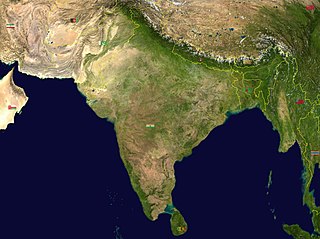
India lies on the Indian Plate, the northern part of the Indo-Australian Plate, whose continental crust forms the Indian subcontinent. The country is situated north of the equator between 8°4' north to 37°6' north latitude and 68°7' east to 97°25' east longitude. It is the seventh-largest country in the world, with a total area of 3,287,263 square kilometres (1,269,219 sq mi). India measures 3,214 km (1,997 mi) from north to south and 2,933 km (1,822 mi) from east to west. It has a land frontier of 15,200 km (9,445 mi) and a coastline of 7,516.6 km (4,671 mi).

The Deccan Plateau is a large plateau in western and southern India. It rises to 100 metres (330 ft) in the north, and to more than 1,000 metres (3,300 ft) in the south, forming a raised triangle within the south-pointing triangle of the Indian coastline.
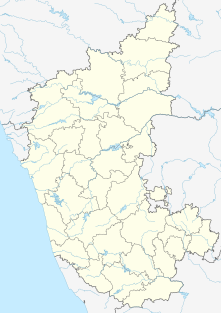
Davanagere is a city in the centre of the southern Indian state of Karnataka. It is the seventh largest city in the state, and the administrative headquarters of eponymous Davanagere district. Hitherto being a cotton hub and hence popularly known before as the Manchester of Karnataka, the commercial ventures of the city is now dominated by education and agro-processing industries. Davanagere became a separate district in 1997, when it was separated from the erstwhile undivided district of Chitradurga for administration conveniences. Davanagere is known for rich culinary traditions which encompass the diversity of entire Karnataka's dishes due to its geographical position in the state as its centre. Notable among them is its aromatic benne dose that is associated with the name of the city.

The North Western Ghats moist deciduous forests is a tropical moist broadleaf forest ecoregion of southwestern India.

The South Western Ghats moist deciduous forests is a tropical moist broadleaf forest ecoregion of southern India. It covers the southern portion of the Western Ghats range and the Nilgiri Hills between 250 and 1000 meters elevation in Kerala, Karnataka and Tamil Nadu states.

Penna is a river of southern India. The Penna rises in the Nandi Hills in Chikkaballapur District of Karnataka state, and runs north and east through the states of Karnataka and Andhra Pradesh to empty into the Bay of Bengal. It is 597 kilometres (371 mi) long, with a drainage basin covering 55,213 km2: 6,937 km2 in Karnataka and 48,276 km2 in Andhra Pradesh. The river basin lies in the rain shadow region of Eastern Ghats and receives 500 mm average rainfall annually.

The South Deccan Plateau dry deciduous forests is a tropical dry forest ecoregion in southern India. The ecoregion lies in the southernmost portion of the Deccan Plateau, and includes the southernmost portion of the Eastern Ghats.
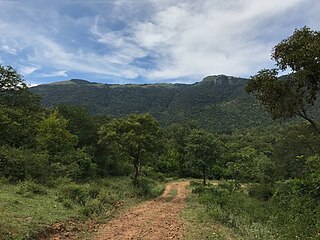
The Biligirirangana Hills, commonly called BR Hills, is a hill range situated in south-eastern Karnataka, at its border with Tamil Nadu in South India. The area is called Biligiriranganatha Swamy Temple Wildlife Sanctuary or simply BRT Wildlife Sanctuary. It is a protected reserve under the Wildlife Protection Act of 1972. Being at the starting point of the Eastern Ghats and very close to Western Ghats, the sanctuary is home to eco-systems that are unique to both the mountain ranges. The site was declared a tiger reserve in January 2011 by the Karnataka government, a few months after approval from India's National Tiger Conservation Authority.
The term Malabar rainforests refers to one or more distinct ecoregions recognized by biogeographers:
- the Malabar Coast moist forests formerly occupied the coastal zone to the 250 metre elevation
- the South Western Ghats moist deciduous forests grow at intermediate elevations
- the South Western Ghats montane rain forests cover the areas above 1000 metres elevation

Hassan is one of the 31 districts of Karnataka, India. The district headquarter is Hassan.
Bangalore is situated in the southeast of the South Indian state of Karnataka. It is positioned at 12.97° N 77.56° E and covers an area of 2,190 square kilometres (850 sq mi). A landlocked city, Bangalore is located in the heart of the Mysore Plateau at an average elevation of 920 metres (3,020 ft). Bangalore district borders with Kolar and Chikkaballapur in the northeast, Tumkur in the northwest, Mandya and Ramanagaram in the southeast and Mysore
The Mysore Plateau, also known as the South Karnataka Plateau, is a plateau that is one of the four geographically unique regions of the Indian state of Karnataka. It has many undulations and is bounded on the west and south by the Western Ghats. Most of the river Kaveri flows through Karnataka in the Mysore Plateau. The average elevation in the region is between 600–900 meters. The plateau covers the districts of Bangalore, Bangalore Rural, Chamarajanagar, Hassan, Kodagu, Kolar, Mandya, Mysore and Tumkur. The name of the plateau is derived from Karunadu. The plateau has an area of about 73,000 square miles and an average elevation of about 2,600 feet. It consists of the Dharwar system of volcanic rocks, crystalline schists, and granites. The major rivers include the Godavari, Krishna, Kaveri, Tungabhadra, Sharavati, and Bhima. The Sharavati has the famous waterfal, known as Jog Falls. These falls are one of the most important sources of hydroelectric power in the country and are also a major tourist attraction. The plateau merges with the Nilgiri Hills in the south. Rainfall varies from 80 inches (2,030 mm) in the southern hills to 28 inches (710 mm) in the northern region.

The Narmada Valley dry deciduous forests are a tropical dry forest ecoregion of central India. The ecoregion lies mostly in Madhya Pradesh state, but extends into portions of Chhattisgarh, Maharashtra, and Uttar Pradesh states.
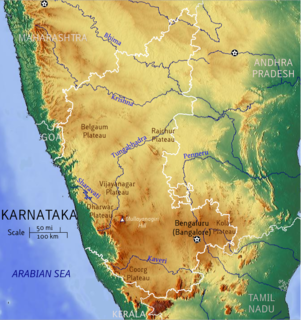
Bayaluseeme or Bayalu Seeme is the area lying to the east of Malenadu, a region of Karnataka state in India. The area is largely open plain, with few hillocks. It includes the districts of Bangalore, Bagalkot, Bijapur, Chitradurga, Davanagere, Dharwad, Gadag, Hassan, Haveri, Mandya, Mysore, Tumkur.

The Indian State of Karnataka is located 11°30' North and 18°30' North latitudes and 74° East and 78°30' East longitude. .It is situated on a tableland where the Western and Eastern Ghat ranges converge into the complex, in the western part of the Deccan Peninsular region of India. The State is bounded by Maharashtra and Goa States in the north and northwest; by the Arabian Sea in the west; by Kerala and Tamil Nadu States in the south and by the States of Andhra Pradesh and Telangana in the east. Karnataka extends to about 750 km from north to south and about 400 km from east to west.

Ghat Roads are access routes into the mountainous Western and Eastern Ghats, mountain ranges of the Indian Subcontinent. These roads are remarkable feats of engineering and most were constructed during the British Raj. Ghat roads were built to connect to the famous Hill Stations established in the mountains for residents to avoid summer heat. They generally served to connect coastal areas with the upper region Deccan plateau of the Indian Subcontinent.
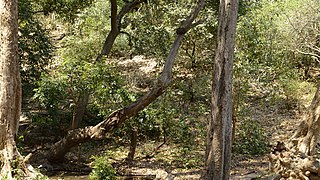
The Central Deccan Plateau dry deciduous forests in Western and Southern India, containing large protected areas of natural tiger habitat.

The Geography of South India comprises the diverse topological and climatic patterns of South India. South India is a peninsula in the shape of a vast inverted triangle, bounded on the west by the Arabian Sea, on the east by the Bay of Bengal and on the north by the Vindhya and Satpura ranges. Technically all Indian territories below the 20th Parallel.
Janardhana Swamy was a Member of parliament, Lok Sabha, India.
References
- ↑ Chisholm, Hugh, ed. (1911). . Encyclopædia Britannica . 19 (11th ed.). Cambridge University Press. p. 116.